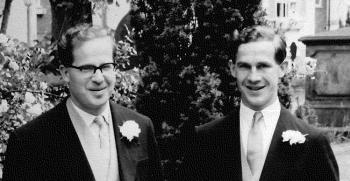Birch Swinnerton-Dyer conjecture

This is a conjecture regarding the number of rational points in elliptic curves i.e. curves in two-dimensional plane with the equation y2 = x3 + a x + b for some whole numbers a,b. In the early 1960’s, the British mathematicians Brian Birch and Peter Swinnerton-Dyer started to use computers to gather data on rational solutions of such equations. The pattern they found led them to a bold conjecture in algebraic number theory which if solved will have major consequences in number theory.
It can be proved that the set of rational points E(Q) on an elliptic curve E forms a commutative group under a geometrically defined addition operation (not the usual coordinate-wise addition). It was also proved by Mordell that E(Q) is finitely generated i.e. there is a finite subset of E(Q) such that every point in E(Q) can be expressed as a sum of elements of this finite subset. By Group theory any finitely generated commutative group is isomorphic (carbon copy) to Zr x G0, where G0 is a finite group, Z is the group of integers and integer r ≥0 is called the rank (in this case the rank of the elliptic curve E). Birch and Swinnerton-Dyer carried out computations on a fast computer to guess a formula for r which gives an idea of how big E(Q) is. In particular they wanted to find whether there are infinite number of rational points on E which will be the case if r > 0. Conceptually they were therefore trying to count the rational points on E. But since this is an infinite set they used modular arithmetic to estimate how big the set really is. For any given prime p, let Np be the number of pairs (x,y) of integers modulo p such that y2 = x3 + a x + b (mod p).
They reasoned that if E(Q) is infinite then p<xNpp should approach infinity as x approaches infinity since Np can be almost p2 for large number of primes p. Conversely they expected that if r = 0, the product remains bounded as x approaches infinity. Their expectations were confirmed when they found that the experimental data fitted the observation that p<xNpp behaves like (log x) r.
To get a conjecture for a formula for r they tried now to obtain an infinite product function L(E,s) which has at least formally a value given by the above product just as in the case of Euler’s product function as a definition of the zeta function. The correct infinite product function in this case was found to be the Hasse-Weil L-function given by
L(E,s) = all primes p(1-1+p- Npp-s + p1-2s)-1
At least formally now L(E,1) is all primes ppNp. However rigorously the infinite product converges only for Re(s) > 3/2. It was expected that L(E,s) has an analytic continuation to the whole complex plane. This was known as Hasse conjecture and is a consequence of another well-known conjecture : the Tanayama-Shimura conjecture. A special case of the last conjecture was proved by Wiles and Taylor on their way of proving Fermat’s Last Theorem. The Tanayama-Shimura conjecture was completely proved in 1999 which proved Hasse conjecture as well. This established that there is an analytic function L(E,s) defined on the whole complex plane which has the above product expansion for Re(s) > 3/2 . In terms of this function then Birch Swinnerton-Dyer conjecture could then be stated as ;
Birch Swinnerton-Dyer Conjecture : For an elliptic curve E, the Taylor expansion of L(E,s) at s = 1 has the form L(E,s) = c (s – 1) r + higher order terms with c ≠ 0 and r = rank(E). In particular, E(Q) is infinite if and only if L(E,1) = 0.
In 2000, this was named as a millennium problem.
Some partial progress have been made by various individuals towards a solution of the problem. A special mention can be made of Professor Manjul Bhargava of Princeton University (see note at the end of this article) and Arul Shankar who contributed a paper to arxiv.org in 2010 reporting some results for the case of rank zero.
The previous three purely mathematical Millennium problems can at least be explained in a way such that a person with a good undergraduate or postgraduate education in Mathematics can understand what the problems are all about. But this is not true of the next problem viz. the Hodge conjecture. Indeed the official statement involves so many layers of abstraction that even very established mathematicians will have difficulty in understanding the technical details. Therefore we shall remain content by providing the official statement and rough explanations of a couple of technical terms.
Note on Professor Manjul Bhargava : Professor Manjul Bhargavais is a Canadian American mathematician of Indian origin. He received his Ph.D. working under Andrew Wiles and was hired as a tenured full Professor within only two years of his receiving his Ph.D. degree. He is also an accomplished tabla player learning under Gurus like Zakir Hussain.
[This is an article in our series of articles on the Millennium Problems.]
